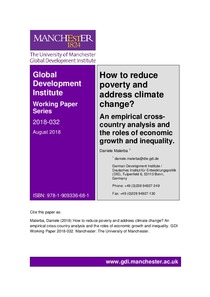How to reduce poverty and address climate change? An empirical crosscountry analysis and the roles of economic growth and inequality
"How can countries eradicate poverty while also addressing climate change? Despite the necessity to deal with both issues simultaneously, no study has analysed the empirical relationship between the two aforementioned goals and the factors that drive these interlinkages. This paper addresses th...
| Main Author: | |
|---|---|
| Institution: | ETUI-European Trade Union Institute |
| Format: | TEXT |
| Language: | English |
| Published: |
Manchester
2018
GDI |
| Subjects: | |
| Online Access: | https://www.labourline.org/KENTIKA-19301873124911290559-How-to-reduce-poverty-and-addr.htm |
| Summary: | "How can countries eradicate poverty while also addressing climate change? Despite the necessity to deal with both issues simultaneously, no study has analysed the empirical relationship between the two aforementioned goals and the factors that drive these interlinkages. This paper addresses this gap in the literature, and the initial research question, by developing a framework to analyse this relationship and its drivers. It then econometrically tests the propositions derived from the framework, using data from 135 developed and developing countries. The paper’s findings show that the carbon intensity of poverty reduction (CIPR), defined as the ratio between proportional changes in emissions levels and the share of the population above the poverty line, is heterogeneous across countries. This heterogeneity is partly explained by economic growth, which is found to have a negative effect on the CIPR up to a certain income level, defined here as a ‘turning point’. Above that turning point, economic growth increases the CIPR. By contrast, inequality reduction is shown to have an unambiguous negative effect on the CIPR. The results are robust for different poverty lines and different model specifications. In addition, the research underlines the tension between policy perspectives at the national and global levels. Economic growth, despite the potential to reduce the national carbon intensity of poverty reduction for the numerous countries that lie below the estimated turning points, needs to confront global environmental boundaries. Given this tension, the paper concludes that, alongside developed countries drastically reducing their emissions, developing countries should follow alternative development paths. Among them, a stronger greening of economic growth or an increased use of cash transfers and inequality-reducing policies are discussed." |
|---|---|
| Physical Description: | 39 p. Digital |

